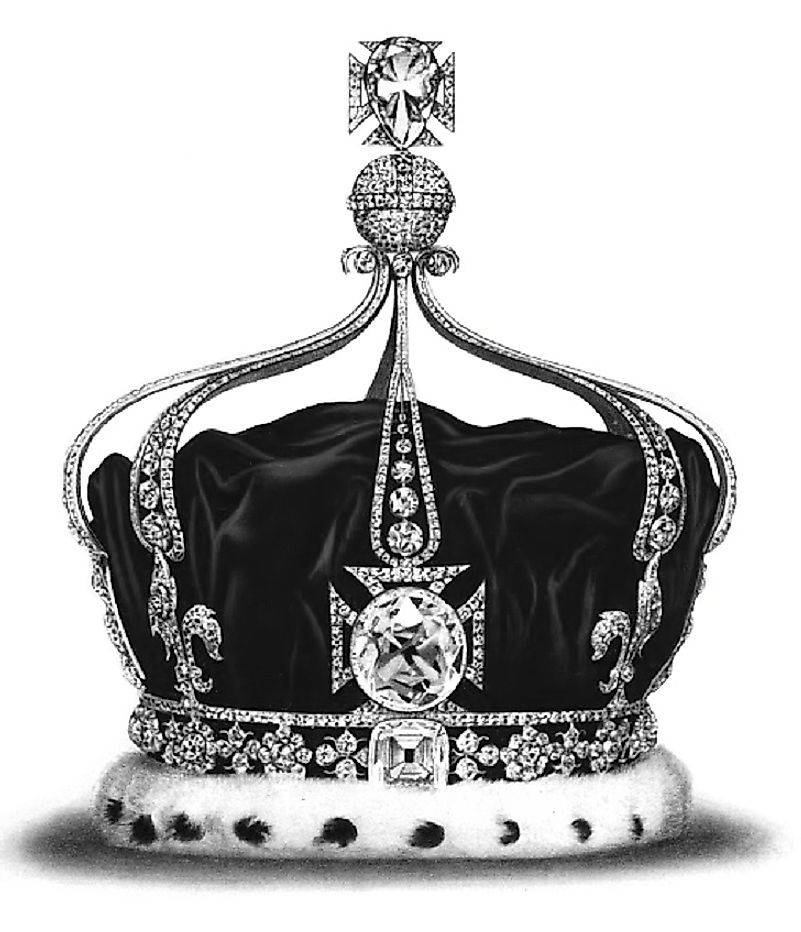Koh-i-Noor: Priceless Diamond Of Andhra Pradesh

5. Description
The Koh-i-Noor, meaning the Mountain of Light in Persian, is the most famous jewel in the world with a long, bloody history and immense sentimental value associated with it The diamond was the largest known diamond of its time, being 793 carats in its original form at the time of discovery after which it was cut down to 186 carats while in possession of the Mughal rulers. When the diamond was acquired by the British, the husband of Queen Victoria, Prince Albert, unsatisfied with the appearance of the diamond, ordered it to be further cut down, resulting in its present value of 105.6 carats, with dimensions of 3.6 centimeters x 3.2 centimeters x 1.3 centimeters. In this present state, the much-coveted Koh-i-Noor diamond rests among the Crown Jewels in the Tower of London in England.
4. Discovery
The history of the Koh-i-Noor dates as far back as 3,000 BC. It is believed that the diamond was obtained by mining activities in the Kollur Mine in the modern-day Guntur District of Andhra Pradesh state of India. Some accounts also state that the a diamond with a similar description as the Koh-i-Noor was mentioned in a 5,000 year-old Sanskrit script, named Syamantaka. However, the true identity of the Syamantaka was never known.
3. Ownership through the Years
For years, the lure of the Koh-i-Noor drew many rulers and invaders to try to extract it both by legitimate and illicit means. Since its discovery, the diamond was the proud possession of the native rulers of the southern states of India until, in 1310, a raid on Warangal by Malik Kafur, a general of the Delhi Sultanate’s ruler, Alauddin Khilji, is believed to have transferred the possession of the Koh-i-Noor into new hands. The stone was then passed on to successive rulers of the Delhi Sultanate until Babur, the founder of the Great Mughal Empire in India acquired it during his invasions of India.
The Koh-i-Noor now became the proud possession of the Mughal Dynasty and Shah Jahan, the great Mughal Emperor, credited with the construction of the Taj Mahal, installed the diamond in his famous Peacock Throne. It was during the rule of his son, Aurangzeb that the diamond was cut down from 793 carats to 186 carats by mistake. In 1739, the diamond again shifted hands from the Mughals to Nader Shah, the Shah of Persia, whose army looted vast volumes of wealth from the royal treasury of the Mughals including the Koh-i-Noor and the Peacock Throne. In 1747 after Nader Shah was assassinated, the future Emir of Afghanistan, Ahmad Shah Durrani, became the owner of the diamond. The Koh-i-Noor returned back to India in 1813 when the fleeing Shah Shujah Durrani, a descendant of Ahmad Shah, gifted the diamond to Maharaja Ranjit Singh of Punjab in return of a favor he had granted him. The Maharaja before his death mentioned in his will that the diamond was to be given to the Jagannath temple in Puri in Orissa but after his death, his wish was never granted.
On March 29, 1849, the Treaty of Lahore was signed between British India and the Kingdom of Punjab after the Sikhs lost their war against the colonial British. The Koh-i-Noor then became the possession of the British. A lot of controversy surrounds the transfer procedure of the Koh-i-Noor at this point of time with strong criticisms against this transfer from both the Indian society and even contemporaries in Britain. Finally, on July 3, 1850, after a long journey in the sea aboard a ship HMS Medea, the Koh-i-Noor was handed over to the Queen of England, its last proud possessor to date.
2. A British Crown Jewel
The Koh-i-Noor after reaching the royal house of Britain was set in various royal crowns of the royal household, the Crown of Queen Alexandra, Queen Mary’s Crown and finally the Queen Mother’s Crown. It was then ultimately displayed to public in the Jewel House at the Tower of London in London. All the crowns that once bore the jewel were also displayed here with a replica of the diamond in the now empty place. The Queen Mother’s Crown on display at the museum bears the original Koh-i-Noor.
1. Ongoing Disputes
Since the acquisition of the Koh-i-Noor by the British has always been controversial, time and again India has demanded a return of the diamond from the British. In 1947 after India’s independence, in 1953 during the coronation year of Queen Elizabeth II, in 2000, and as recently as 2016, the Indian Government has asked the British to return back the diamond, which the country feels is rightfully owned by India. Other countries like Pakistan and Afghanistan have also claimed ownership to the diamond in the past.











